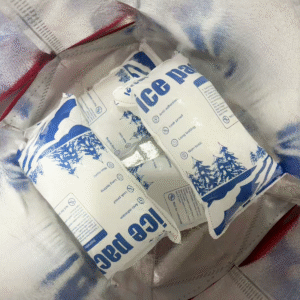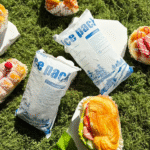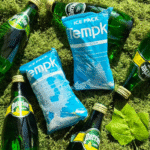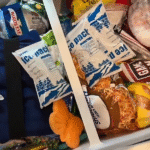Embalar leite materno com gelo seco garante o transporte seguro de longa distância, mantendo o leite congelado. Se você é um pai viajante ou enviando leite materno, using dry ice provides an effective solution to preserve freshness. Neste guia, we’ll break down everything you need to know about packing breast milk with dry ice safely and efficiently.
-
How to pack breast milk with dry ice step-by-step?
-
Safety precautions for handling dry ice
-
2025 trends in cold chain packaging for breast milk
Why Use Dry Ice for Breast Milk Transportation?
Dry ice is the preferred option for shipping breast milk over long distances due to its extremely low temperature, which keeps the milk frozen longer than regular ice or gel packs. Ao contrário do gelo tradicional, que derrete e cria água, gelo seco sublima de sólido ao gás, não deixando nenhum resíduo. This property helps prevent milk from thawing or becoming wet, preserving its nutrients during transit.
Expert Tip: Dry ice is most suitable for trips lasting over 12 horas, ensuring the milk remains frozen without the need for refills.
Gelo seco vs.. Pacotes de gel: O que é melhor?
| Método de resfriamento | Aprox.. Duração | Manuseio de precauções | O que isso significa para você |
|---|---|---|---|
| Gelo Seco | 24-48 horas | Use luvas isoladas, store in ventilated containers | Best for long travels |
| Bolsas de gelo em gel | Até 24 horas | Seguro para manusear, easy to replenish | Suitable for short trips |
| Gelo regular | 12-24 horas | Can cause melting and mess | Inconsistent for shipping |
Resumo: Dry ice is essential for long-distance travel or shipping, while gel packs suffice for short trips.
Step-by-Step Guide to Packing Breast Milk with Dry Ice
1. Freeze the Milk Properly
Ensure that the milk is fully frozen before packing. Use durable breast milk storage bags or bottles, leaving space at the top for expansion as the milk freezes.
2. Escolha o refrigerador certo
An insulated cooler, preferably made of Styrofoam or vacuum-insulated material, will help maintain the desired temperature. Avoid using regular picnic coolers as they may not provide adequate insulation.
3. Layer the Milk and Dry Ice
Place a layer of dry ice at the bottom of the cooler. Então, place the frozen milk containers on top of the dry ice, ensuring there is a barrier (like newspaper) between the dry ice and the milk to prevent direct contact. Repeat the process, alternating layers of milk and dry ice.
4. Seal and Ventilate the Cooler
Close the cooler tightly but leave a small gap or use a vented cooler to allow the carbon dioxide gas to escape as the dry ice sublimates.
Dica: Always label the cooler with “Dry Ice UN 1845” and include the net weight of the dry ice, as required by airline and shipping regulations.
5. Select Shipping Method
For the safest transportation, use expedited services like overnight or 2-day shipping. Avoid shipping over the weekend to prevent extended transit times.
How Long Will Dry Ice Keep Breast Milk Frozen?
The duration that dry ice will keep breast milk frozen depends on the amount of dry ice used and the external temperature. Aqui estão algumas diretrizes gerais:
-
5-10 libras de gelo seco will keep milk frozen for 24-36 horas.
-
10-20 libras de gelo seco can keep the milk frozen for 48 horas ou mais.
Expert Tip: Estimate your travel time and adjust the amount of dry ice accordingly. More dry ice may be needed for longer trips or warmer climates.
Common Mistakes to Avoid When Packing Breast Milk with Dry Ice
-
Not Ventilating the Cooler Properly
Ensure there is enough ventilation to allow the carbon dioxide gas to escape. Sem ventilação, the cooler can rupture. -
Usando muito pouco gelo seco
Underestimating the amount of dry ice needed could cause the milk to thaw prematurely. Always calculate the required dry ice based on travel time. -
Packing Milk in Glass Containers
Glass can crack under the extreme cold of dry ice. Stick to plastic or purpose-built storage bags.
2025 Trends in Dry Ice for Breast Milk Transport
À medida que a indústria da cadeia fria avança, new materials and technologies have emerged to improve breast milk transportation:
-
Isolamento Ecológico: Biodegradable materials are now used to improve the sustainability of dry ice transportation.
-
Monitoramento de temperatura inteligente: Advanced temperature sensors, integrated into shipping containers, allow real-time tracking of conditions during transit, ensuring milk stays frozen.
-
Captured CO₂ Dry Ice: Em 2025, dry ice made from captured carbon dioxide is becoming popular as a more eco-friendly option.
Perguntas frequentes: Common Questions About Packing Breast Milk with Dry Ice
Q1: How much dry ice do I need for a 24-hour shipping time?
Use aproximadamente 5-10 libras de gelo seco para 24-36 horas de tempo de envio.
Q2: Can I use gel packs instead of dry ice?
Gel packs are useful for short trips but cannot maintain the freezing temperatures required for long-distance breast milk transport.
Q3: Como faço para descartar restos de gelo seco?
Allow dry ice to sublimate outdoors in a well-ventilated area. Never dispose of it in sinks or toilets.
Conclusão & Recomendações
Packing breast milk with dry ice is the safest way to ensure it stays frozen during long-distance transport. By following the steps and safety guidelines outlined in this guide, you can confidently ship your milk to its destination. Remember to estimate the amount of dry ice needed, choose the right cooler, e garantir ventilação adequada.
PRÓXIMOS PASSOS:
-
Select the appropriate cooler and dry ice.
-
Pack the milk in leak-proof, frozen containers.
-
Use expedited shipping for faster delivery.
-
Follow safety protocols when handling dry ice.
























